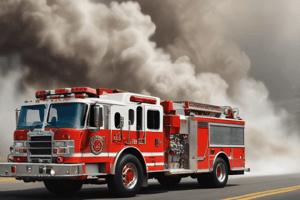Podcast
Questions and Answers
What is the purpose of providing basic information in an initial radio report?
What is the purpose of providing basic information in an initial radio report?
- To report on past incidents in the area
- To entertain the incoming units
- To impact the actions of incoming units based on assignments (correct)
- To delay the response time of the units
Which component is NOT included in the initial radio report?
Which component is NOT included in the initial radio report?
- Smoke/Fire Conditions Present
- Name of the Incident Commander (correct)
- Type of Occupancy
- Actions Being Taken
What does the '360°' assessment involve?
What does the '360°' assessment involve?
- Focusing only on visible fire conditions
- Only identifying hazards inside the building
- Completing a full perimeter check of a building (correct)
- Evaluating personnel readiness
What are the components of the acronym used in initial radio reports?
What are the components of the acronym used in initial radio reports?
What does 'Conditions Actions Needs (CAN)' follow after?
What does 'Conditions Actions Needs (CAN)' follow after?
Which statement correctly describes a unique construction type?
Which statement correctly describes a unique construction type?
What should you report if you can't complete a 360° assessment?
What should you report if you can't complete a 360° assessment?
What should the follow-up report (FUR) include?
What should the follow-up report (FUR) include?
Why is it important to announce the operational mode?
Why is it important to announce the operational mode?
What does the term 'flow path of fire and fire gases' refer to?
What does the term 'flow path of fire and fire gases' refer to?
Flashcards are hidden until you start studying
Study Notes
Initial Radio Report
- Initial reports are essential for informing incoming units at the fireground and guiding their actions based on Standard Operating Guidelines.
- Key components include arriving unit(s), building size, building height, type of occupancy, unique construction, smoke/fire conditions, establishment of command, actions taken, and instructions for incoming units.
- Use the acronym IDEAL to structure the report:
- I - Identify arriving unit(s)
- D - Describe observations
- E - Establish command
- A - Outline actions being taken
- L - Provide instructions to incoming units
360° Overview
- Conduct a complete 360° assessment of the scene; if not possible, communicate observed conditions.
- Identify known or potential rescue situations.
- Determine active and potential flow paths for fire and gases.
- Pinpoint the location and extent of the fire within the structure.
- Assess the size, construction, age, and structural stability of the building.
- Recognize any hazards present at the scene.
Follow-up Report (FUR)
- Follows the initial 360° assessment, providing additional updates on conditions and hazards.
Conditions Actions Needs (CAN)
- Comprehensive update following a 360° view.
- Details updates on current conditions and identifies potential hazards such as basements and overhead wires.
Confirm Fire Location
- Verify and announce the precise location of the fire to facilitate response coordination.
Operational Mode and Actions
- Clearly announce the operational mode and specify actions taken to ensure all units are informed on the strategy being employed.
Resource Requests
- Make necessary requests for additional resources as dictated by the evolving situation.
Studying That Suits You
Use AI to generate personalized quizzes and flashcards to suit your learning preferences.




